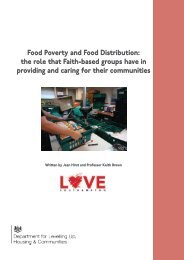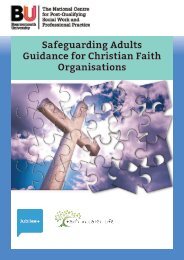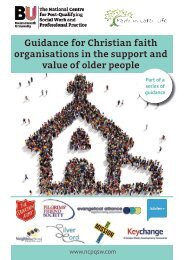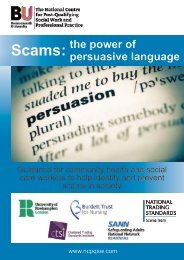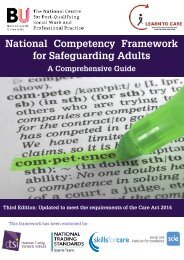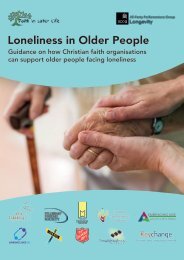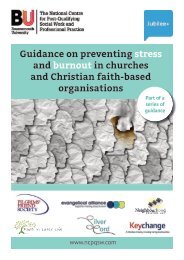0-Coercion and control report with pics FINAL
Coercion and control are used in both domestic and financial abuse. There are also differences in how agencies approach these concerns, and we seek to highlight this to learn from and utilise best practice.
Coercion and control are used in both domestic and financial abuse. There are also differences in how agencies approach these concerns, and we seek to highlight this to learn from and utilise best practice.
You also want an ePaper? Increase the reach of your titles
YUMPU automatically turns print PDFs into web optimized ePapers that Google loves.
aising literature. Common messages assume that the victim makes bad decisions <strong>with</strong>in<br />
normal communicative frameworks <strong>and</strong> that they can step away from their entrenchment<br />
in an emotional manipulation in order to assess <strong>and</strong> remedy their situation’ (Carter<br />
2021:298).<br />
If we start to see vulnerability as a temporary state (such as recent bereavement) this might<br />
help us to engage more productively <strong>with</strong> victims. Changes in adult social care terminology<br />
reflect this already - a move from ‘vulnerable adults’ to ‘adults at risk’ has taken place<br />
‘which moves the focus from notions of vulnerability, which has been associated <strong>with</strong><br />
blaming the individual’ (Lee et al 2018b:7). The presence of cognitive decline does not<br />
mean the victim was always vulnerable - or is beyond any financial capability now either.<br />
We also need to underst<strong>and</strong> the marketplace we are living in, be aware of the evolving<br />
nature of financial abuse <strong>and</strong> design our services <strong>with</strong> the most vulnerable in mind.<br />
Case study ‘Tom’<br />
Social services <strong>and</strong> Trading St<strong>and</strong>ards visit Tom* who is 78 <strong>and</strong> lives alone after his wife<br />
died 2 years ago. He is a victim of an investment scam. He is adamant he has not been<br />
scammed <strong>and</strong> wants to continue his involvement. The workers explain that research<br />
shows that victims of investment scams are particularly financially savvy - <strong>and</strong> how the<br />
scammers keep using complimentary language to Tom in their emails. They explain that<br />
people who have been recently bereaved are often targeted, <strong>and</strong> Tom starts to see that<br />
he fits into both of these target audiences. Over time he talks about why he started<br />
responding - something to keep him busy <strong>and</strong> fill the long hours when he missed his<br />
wife - <strong>and</strong> agrees to have some time out of the house <strong>and</strong> feels he can leave it a bit<br />
longer before he responds next time the ‘company’ (scammers) get in touch. Workers<br />
check in <strong>with</strong> him after this delay <strong>and</strong> he tells them he didn’t like the way the company<br />
called him so many times to chase payment <strong>and</strong> he’s thinking twice about the<br />
‘investment’ now. Here we can see Tom has started to create boundaries he feels<br />
comfortable <strong>with</strong>. He’s started to see that perhaps this is not the right ‘company’ to<br />
invest in. He may never acknowledge he has been scammed but it is likely he will<br />
<strong>with</strong>draw from giving them anymore money <strong>and</strong> be guarded next time a scammer<br />
contacts him.<br />
The phrase ‘good enough is good enough’ comes to mind - are we expecting victims to<br />
come full circle <strong>and</strong> acknowledge the full extent of the financial abuse - are we allowing<br />
victims to successfully <strong>with</strong>draw from engagement on their terms even if risk is not<br />
completely removed? In their (2018) study, Fenge <strong>and</strong> Lee found that there is an<br />
element of ‘right person right time’ - in these cases, professional intervention occurred<br />
at a time when the individual was ready to accept advice. However, for other<br />
participants, their loneliness <strong>and</strong> isolation were more enduring <strong>and</strong> impacted on their<br />
readiness to accept intervention to stop their contact <strong>with</strong> scammers’ (Fenge <strong>and</strong> Lee<br />
2018:913). What can we learn from domestic abuse best practice here? The importance<br />
of empathy, shared experiences <strong>and</strong> peer to peer support are vital <strong>and</strong> the recovery<br />
process for individuals needs attention.<br />
14




